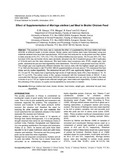Effect of Supplementation of Moringa oleifera Leaf Meal in Broiler Chicken Feed

View/
Date
2014Author
Gakuya, D.W
Mbugua, P.N
Kavoi, B.
Kiama, S.G
Metadata
Show full item recordAbstract
The purpose of this study was to evaluate the effect of supplementing Moringa oleifera leaf meal
(MOLM) at different levels in broiler chicken. Broiler starter and finisher diets were formulated using raw
materials obtained from local feed manufacturers. MOLM was first analyzed for crude protein and then added
to diets at levels of 0% (T1), 7.5% (T2), 7.5% (T3) (without Methionine and lysine), 15 (T4) and 30% (T5). Two
hundred (200) day old broiler chicks were randomly allocated into the 5 treatment groups with 4 replicates
of 10 birds each and the diets introduced. The feed intake, feed conversion ratio (FCR), weight gain, lipid
profile, abdominal fat pad and feed digestibility were determined. The MOLM crude protein level was 23.33%.
The weight gain was significantly different between the various diets with the highest weight gain being in
T1 at 1464 and the lowest in diet T5 at 500. MOLM supplementation at levels above 7.5% decreased the feed
intake and dry matter digestibility. The abdominal fat pad (AFP) was significantly higher in T1 compared to
T2, T4 and T5. The males had a significantly high levels of High density lipids (HDL) than females in T2, T3
and T4 (p<0.05). The yellow colour of the carcass increased with the increased levels of MOLM. It was
concluded that Moringa oleifera leaf meal (MOLM) was well tolerated and can only be included in the feed
to levels of up to 7.5% as higher levels affected weight gain, feed intake and digestibility. Further studies on
the yellowing of the carcass, its quality and acceptability by consumers is needed.
Citation
Faculty of Veterinary Medicine, University of NairobiPublisher
International Journal of Poultry Science 13 (4): 208-213, 2014
